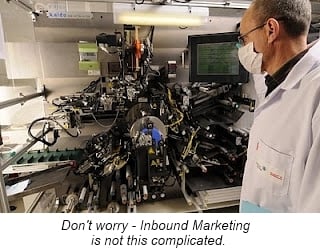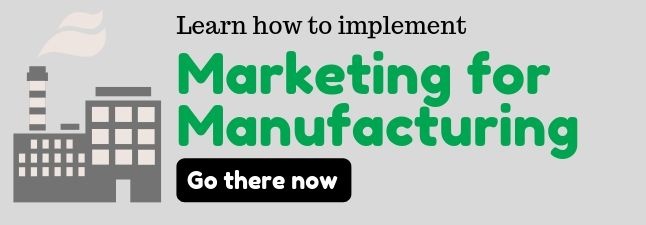Posted by Todd Hockenberry ● Jun 15, 2017
How to create an Inbound Marketing Engine for Manufacturing Companies
Do you have a website that is an inbound marketing engine, attracting people to your manufacturing company and your solutions, or do you have a site that is little more than a digital version of your sales literature?
 The first step in creating an inbound marketing engine with your manufacturing website is identifying the difference between the goal (a marketing engine) and a catalog website.
The first step in creating an inbound marketing engine with your manufacturing website is identifying the difference between the goal (a marketing engine) and a catalog website.
So, What is a Marketing Engine?
An inbound marketing engine for manufacturing starts with a solid core of a good website. First, the site is optimized using accepted white hat SEO best practices. This type of site is also optimized and responsive for mobile viewers and looks modern and fresh. This site doesn’t have broken links or dead pages.
Beyond the basics of a good website, a marketing engine is built around content. The site has great content that targets a specific type of customer or your ideal buyer persona and is regularly updated with fresh, relevant information that the target prospect seeks out and wants to consume. This site delivers ever-increasing, ongoing value to the target prospects and customers of the company through this content.
A good inbound marketing for manufacturing site also has calls to action and landing pages that attract visitors to unique and valuable content that they then willingly exchange their contact information for, giving you permission to talk to them. A good inbound marketing for manufacturing site also uses lead nurturing, which is tied to the type of offer consumed by the visitor, to communicate with them through the buying cycle and to keep providing helpful content after the initial conversion.
The site is integrated with varied social media accounts (YouTube, Facebook, Twitter, LinkedIn, Pinterest, to name a few) that allow visitors to engage you how and when they choose to.
A good inbound marketing for manufacturing site is a critical asset and strategic choice for a manufacturing company. It is an asset that delivers a return that is measurable and manageable. It delivers results in the form of marketing and sales-ready leads, and measurably drives business goals like revenue and margin.
What is a Catalog Website
On the other hand, you have a catalog website if:
- You have less than 50 pages total on the site
- You only list your products and not what they actually do for customers
- Most of your pages are listings of part numbers and specifications
- You have no blog
- You have no landing pages to convert visitors to leads
- You have no social media accounts, much less use them regularly
- You do not show any in-the-field application photos or videos
- You never explain why you are different, better, faster, easier, or superior to your competition or technological alternatives
- You have not updated the site in 3 years, and the design looks like it was done in 1987
- You cannot make updates to the site without calling a developer (if you even remember their number)
In short, a catalog website is one that is all about you and your products and not about them, the customer, and what they are looking for, and what you actually deliver to them in terms of value and how you help them.
Hopefully, you don't have a business card website - name, address, and number only, please.
How Do You Go from a Catalog to a Marketing Engine?
If your website needs some (or a lot) of work to get from a catalog to a marketing engine, it can be a bit overwhelming. Understanding what a marketing engine website is helps, but chances are if you’re in the catalog camp you’d rather have specific directions to follow to get out of it.
Before we get to specifics, however, let’s talk about being helpful. Why should you care about being helpful? Well…
74% of sales go to the first company that was helpful (there are various sources for this stat and others like it, here is one).
One of the best vehicles for being helpful is your website. Your website is often the first place a prospect will interact with you, and it is often the easiest way to prove your helpful worth.
Think about it this way, when you have a problem is your first step picking up a phone and calling a company’s sales department? Probably not. It’s far more likely you’re going to go online and search around for a solution. Ultimately, the solution might require you to pick up your phone or place an order, but long before you get to that point, you’re more likely than not going to do some research on your own.
This is why being helpful often comes in the form of content (one of the things that marketing engines nail). As you move toward becoming a marketing engine remember to keep in mind the importance of being helpful.
Nail the Basics
Step one of becoming a marketing engine is to create a rock-solid platform. This is where all the website best practices come into play. What those best practices are, what makes a good website, is constantly changing as the internet evolves. What was standard ten years ago, or even five isn’t necessarily going to fly today.
The best way to figure out what’s in vogue at the moment is to do some research. In general, however, there are a couple of things that probably won’t go out of style. For instance, mobile optimization is a must that doesn’t show any signs of going away. Testing your links and pages to make sure they work and display correctly is also a good, standard best practice.
We are huge fans of HubSpot (call us if you want to learn more about this awesome tool) for site hosting and marketing automation and most of our customers use it very successfully.
Next, Helpful Content is the Best Content
Your next step on the journey from catalog to marketing engine is content. Content is the fuel that powers the best marketing engines, so you need to make sure you really get it right.
Content creation is a huge topic, and we’ve spent some time covering it in detail. In general, however, as you begin to create content it is often useful to take a moment and ask yourself, “Is this piece of content helpful? Could it help someone solve a problem?” If the answer is yes, then you’re probably on to something.
Want some more details on how to create content? Here are a couple of articles I’ve written that specifically deal with this topic:
- How to Blog for Manufacturing
- 5 Reasons to Blog and Get Manufacturing Revenue Growth
- Crafting a Blog Post for Your Business: 4 Keys to Success
Leverage Your Content
The next step is leveraging your content. This means creating landing pages and calls-to-action built around solid, helpful content. If prospects want your content, then they will be willing to part with their contact details. This opens the door for you to talk with them.
Marketing engines also make use of lead nurturing. Lead nurturing can help take a top-of-the-funnel lead and turn them into a customer, so it is vital that you build lead nurturing into your efforts.
The Next Step
Moving from a catalog website toward a marketing engine is a process that takes dedication and planning. You aren’t going to be able to give this five minutes of time and expect results. You need a plan and measurable goals to achieve success in this arena.
An engine produces power that can be used to move - the same hold true for your marketing engine. Create a repeatable marketing engine and you will see more and more leads that will drive your business forward.
Want to learn more, check out these articles:
Topics: Marketing, Manufacturing





